CBSE Class 12 Physics MCQs Solution All Chapters
Free PDF Download of CBSE Physics Multiple Choice Questions for Class 12 with Answers Chapter 1 Electric Charges and Fields. Physics MCQs for Class 12 Chapter Wise with Answers PDF Download was Prepared Based on Latest Exam Pattern. Students can solve NCERT Class 12 Physics Electric Charges and Fields MCQs Pdf with Answers to know their preparation level.
- Class 12 Physics Electric Charges and Fields MCQs Pdf 1
- Class 12 Physics Electric Charges and Fields MCQs Pdf 2
Current Electricity MCQ Chapter 3
Electric current is the rate of flow of negative charges in a conductor.
Below are some of the very important NCERT Current Electricity MCQ Class 12 Physics Chapter 3 with answers. These Current Electricity MCQ have been prepared by expert teachers and subject experts based on the latest syllabus and pattern of CBSE Term 1 examination.
We have given these Current Electricity MCQ Class 12 Physics Questions with Answers to help students understand the concept.
MCQ Questions for Class 12 Physics are very important for the latest CBSE Term 1 and Term 2 pattern. These MCQs are very important for students who want to score high in CBSE Board, NEET and JEE exam.
Free PDF Download of CBSE Physics Multiple Choice Questions for Class 12 with Answers Chapter 3 Current Electricity. Physics MCQs for Class 12 Chapter Wise with Answers PDF Download was Prepared Based on Latest Exam Pattern. Students can solve NCERT Class 12 Physics Current Electricity MCQs Pdf with Answers to know their preparation level.
Current Electricity MCQ 1-45
1 . The relaxation time in conductors
- increases with increase in temperature
- decreases with increase in temperature
- it does not depend on temperature
- all of sudden changes at 400 Kelvin
Answer/Explanation
2
2. A metal wire is subjected to a constant potential difference. When the temperature of the metal wire increases, the drift velocity of of the electron in it
- increases, thermal velocity of electron increases
- decreases, thermal velocity of electron increases
- increases, thermal velocity of electron decreases
- decreases, thermal velocity of electron decreases
Answer/Explanation
2
3. Drift velocity of a free electron inside a conductor is
- the thermal speed of the free electron
- the speed with which a free electron emerges out of the conductor
- the average speed required by the electron in any direction
- the average speed of the electron between successive collisions in the direct opposition to opposite to the applied electric field
Answer/Explanation
4
4. The electric resistance of a certain wire of iron is R if its length and radius are both doubled then
- the radius and the specific radius resistance will both remain unchanged
- the resistance will be doubled, then the specific resistance will be halved
- the resistance will be halved, and the specific resistance will remain unchanged
- the resistance will be halved, and then the specific resistance will be doubled
Answer/Explanation
3
5. When no current is passed through a conductor
- the free electrons do not move
- the average speed of a free electron over a large period of time is not zero
- the average velocity of a free electron over a large period of time is zero
- the average of the velocities of all the free electrons at an instant is non zero
Answer/Explanation
4
6. The time rate of flow of charge through any cross section of a conductor
- Electric potential
- Electric current
- Electric intensity
- Electric charge
Answer/Explanation
2
7. When a current I is set up in a wire of radius r, the drift velocity is vd. If the same current is set up through a wire of radius 2r, the drift velocity will be
- 4vd
- 2vd
- vd/2
- vd/4
Answer/Explanation
4
8. If a current of 0.5 A flows in a 60 W lamp, then the total charge passing through it in two hours will be
- 1800 C
- 2400 C
- 3000 C
- 3600 C
Answer/Explanation
4
9. Two wires A and B of the same material, having radii in the ratio 1:2 and carrying currents in the ratio 4:1. The ratio of drift speed of electrons in A and B
- 16:1
- 1:16
- 1:4
- 4:1
Answer/Explanation
1
10. In a potentiometer experiment, when the galvanometer shows no deflection, then no current flows through
- Potentiometer wire
- Galvanometer circuit
- Main circuit
- Battery
Answer/Explanation
3
11. In a wheatstone bridge in the battery and galvanometer are interchanged then the deflection in galvanometer will
- Change in previous direction
- Not change
- Change in opposite direction
- None of these
Answer/Explanation
2
12. Ohm’s law is valid when the temperature of the conductor is ___________
- Constant
- Very high
- Very low
- Varying
Answer/Explanation
1
13. A wire has a non-uniform cross-section as shown in the figure. If a steady current is flowing through it, then the drift speed of the electrons

- Is constant throughout the wire
- Decreases from A and B
- Increases from A and B
- Varies randomly
Answer/Explanation
2
14. A wire of resistance 4Ω is stretched to twice its original length. The resistance of stretched wire would be
- 2Ω
- 4Ω
- 8Ω
- 16Ω
Answer/Explanation
4
15. The instrument among the following which measures the emf of a cell most accurately is
- A voltmeter
- An ammeter
- Potentiometer
- Post office box
Answer/Explanation
3
16. In meter bridge or wheatstone bridge for measurement of resistance, the known and the unknown and the unknown resistance are interchanged. The error so removed is
- End correction
- Index error
- Due to temperature effect
- Random error
Answer/Explanation
1
17. In a closed circuit, the vector sum of total emf is equal to the sum of the ___________
- Currents
- Resistance
- Products of currents and the resistance
- Products of potential differences
Answer/Explanation
3
18. Kirchhoff’s second law is based on the law of conservation of
- Charge
- Energy
- Momentum
- Sum of mass and energy
Answer/Explanation
2
19. Kirchhoff’s first law at a junction is based on the law of conservation of
- Charge
- Energy
- Momentum
- Angular momentum
Answer/Explanation
1
20. When the length and area of cross-section both are doubled, then its resistance
- Will become half
- Will be doubled
- Will remain the same
- Will become four times
Answer/Explanation
3
21. For a metallic wire, their ratio V/I
- Is independent of temperature
- Increases as the temperature rises
- Decreases as the temperature rises
- Increases or decreases as temperature rises, depending upon the metal
Answer/Explanation
2
22. A certain wire has resistance R. The resistance of another wire identical with the first except having twice its diameter is
- 2R
- 0.25R
- 4R
- 0.5R
Answer/Explanation
2
23. The resistance of a straight conductor does not depend upon it
- Temperature
- Length
- Material
- Shape of cross-section
Answer/Explanation
4
24. In meter bridge or wheatstone bridge for measurement of resistance, the known and the unknown resistance are interchanged. The error so removed is
- End correction
- Index error
- Due to temperature effect
- Random error
Answer/Explanation
1
25. Two cells of emf’s approximately 5V and 10V are to be accurately compared using a potentiometer of length 400cm
- The battery that runs the potentiometer should have voltage of 8V
- The battery of potentiometer can have a voltage of 15V and R adjusted so that the potential drop across the wire slightly exceeds 10V
- The first portion of 50 cm of wire itself should have a potential drop of 10V
- Potentiometer is usually used for comparing resistance are not voltages
Answer/Explanation
2
26. Which of the following characteristics of electrons determines the current in a conductor?
- Drift velocity alone
- Thermal velocity alone
- Both drift velocity and thermal velocity
- Neither drift nor thermal velocity
Answer/Explanation
1
27. A potential difference of 10 V is applied across a conductor of length 0.1 m. If the drift velocity of electrons is 2 x 10-4 m/s, the electron mobility is ________ m2V-1s-1
- 1 x 10-6
- 2 x 10-6
- 3 x 10-6
- 4 x 10-6
Answer/Explanation
2
28. In wheatstone bridge, three resistors P, Q, R are connected in three arms in order and 4th arm S is formed by two resistors S1 and S2 connected in parallel. The condition for bridge to be balanced is P/Q
- R(S1+S2) / S1S2
- S1S2 / R(S1+S2)
- RS1S2 / (S1 + S2)
- (S1 + S2) / RS1S2
Answer/Explanation
1
29. According to kirchoff’s law, in any analytical circuit. If the direction of current is assumed opposite, then the value of current will be
- i
- 2i
- -i
- 0
Answer/Explanation
3
30. Consider a current carrying wire in the shape of a circle. Note that as the current progresses along the wire, the direction of j (current density) changes in an exact manner, while the current I remain unaffected. The agent that is essentially responsible for is
- Source of emf
- Electric field produced by charges accumulated on the surface of wire
- The charges just behind a given segment of wire which push them just the right way by repulsion
- The charges ahead
Answer/Explanation
2
31. The reciprocal of resistance is
- Conductance
- Voltage
- Resistivity
- Reactance
Answer/Explanation
1
32. A potential difference V is applied to a copper wire. If the potential difference is increased to 2V, then the drift velocity of electrons will
- Be double the initial velocity
- Remain same
- Be √2 times the initial velocity
- Be half the initial velocity
Answer/Explanation
1
33. Power dissipated in the circuit shown in the figure. The value of R is
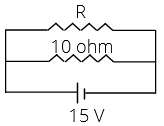
- 5Ω
- 15Ω
- 10Ω
- 20Ω
Answer/Explanation
4
34. A 100W, 200V bulb is connected to a 160V supply. The actual power consumption would be
- 185W
- 100W
- 54W
- 64W
Answer/Explanation
4
35. How many electrons constitute the current of one micro ampere in one second?
- 6.25 x 108
- 6.25 x 1012
- 6.25 x 109
- 6.25 x 1015
Answer/Explanation
2
36. Which of the following is not the advantage of carbon resistors?
- It is small in size and is light in weight
- It has low-temperature coefficient value
- Using it high-value resistor can easily be made
- It has high a power rating with a low tolerance value
Answer/Explanation
4
37. The length of a potentiometer wire is l. A cell of emf E is balanced at a length l/3 from the positive end of the wire. If the length of the wire is increased by l/2. At what distance will the same cell give a balance point?
- 2l / 3
- l / 2
- l / 6
- 4l / 3
Answer/Explanation
2
38. In a meter bridge setup, which of the following should be the properties of the one meter long wire?
- High resistivity and low temperature coefficient
- Low resistivity and low temperature coefficient
- Low resistivity and high temperature coefficient
- High resistivity and high temperature coefficient
Answer/Explanation
1
39. Four conductors of resistance 4, 3, 9 and 6 ohm are connected in AB, BC, CD and DA arms of a wheatstone bridge. The bridge can be balanced by connecting
- 6 ohm in series with 3 ohm conductor
- 4 ohm in parallel with 6 ohm conductor
- 3 ohm in series with 3 ohm conductor
- 5 ohm in series with 6 ohm conductor
Answer/Explanation
3
40. Two cells each of electromotive force E and internal resistance r are connected in parallel across the resistance R. The maximum energy given to the resistor per second if
- R = r/2
- R = r
- R = 2r
- R = 0
Answer/Explanation
1
41. The resistance of a wire at temperature t°C and 0°C are relatable by
- Rt = R0 ( 1 + ɑt )
- Rt = R0 ( 1 – ɑt )
- Rt = R02 ( 1 + ɑt )
- Rt = R02 ( 1 – ɑt )
Answer/Explanation
1
42. The resistance of resistance R is connected to 25V supply and heat produced in it 25J sec. The value of R is
- 225Ω
- 1Ω
- 25Ω
- 50Ω
Answer/Explanation
3
43. The temperature coefficient of resistance of a wire is 0.00125per°C. At 300K, its resistance is 1Ω. This resistance of the wire will be 2Ω at
- 1154K
- 1100K
- 1400K
- 1127K
Answer/Explanation
2
44. Three resistances R1, R2 and R3 (R1 > R2 > R3) are connected in series. If current I1, I2 and I3 respectively is flowing through them, the correct relation will be
- I1 = I2 = I3
- I1 > I2 > I3
- I1 < I2 < I3
- I1 > I2 < I3
Answer/Explanation
1
45. How many resistors of 176Ω should be connected in parallel to get 5A current from 220 V supply
- 2
- 3
- 6
- 4
Answer/Explanation
4
Assertion and Reasoning MCQ
Codes
(a) Both A and R are true and R is the correct explanation of A
(b) Both A and R are true and but R is not a correct explanation of A
(c) A is true but R is false
(d) A is false, but R is true
1 . Assertion Current density at any point is ohmic resistor is in direction of electric field at that point.
Reason A point charge when released from rest in a region having only electric field always move along electric lines of force.
Answer/Explanation
1 . (c)
From the relation j = σE the current density j at any point in ohmic resistor is in direction of electric field E at that point. In space having non-uniform electric field, charges released from rest may not move along electric line of force.
2. Assertion The 200 watt bulb glow with more brightness than hundred watt bulb.
Reason 100 watt bulb has more resistance than a 200 watt bulb.
Answer/Explanation
2. (a)
P = V2 / R
R = V2 / P
R ∝ 1 / P
Higher the power of bulb, lesser will be the resistance and thus, the bulb will glow more.
3. Assertion bending a wire does not affect electrical resistance.
Reason resistance of wire is proportional to resistivity of material.
Answer/Explanation
3. (a)
When wire is bent, the resistivity, length and area do not change and thus, the resistance also remains unchanged.
4. Assertion Fuse wire must have high resistance and low melting point.
Reason Fuse is used for small current flow only.
Answer/Explanation
4. (3)
Fuse wire should have high resistance because in series, current remains same, therefore according to Joule’s law,
H = (I2Rt / 4.2) cal
Heat produced is high if R is high. The melting point must be low so that wire may melt with increase in temperature. As the current equal to maximum safe value, flows through the fuse wire, it heats up, melts and break the circuit.
5. Assertion Two electric bulbs of 50 Watt and hundred what are given when connected in series 50 Watt bulb glows more but when connected in parallel hundred watt bulb glows more.
Reason In series combination power is directly proportional to the resistance of the circuit but in parallel combination power is inversely proportional to the resistance of the circuit.
Answer/Explanation
5. (1)
Resistance of 50W bulb is two times the resistance of 100W bulb. When bulbs are connected in series, 50W bulb will glow more as P = I2R. In parallel, the 100W bulb will glow more as P = V2/R.
6. Assertion When current through a bulb decreases by 0.5 % the glow of bulb decreases by 1%.
Reason Glow (power) which is directly proportional to square of current.
Answer/Explanation
6. (1)
Glow = Power = I2R
dP/P = 2(dI/I) = 2 x 0.5 = 1%
7. Assertion Two bulbs of some wattage, one having a carbon filament and the other having a metallic filament are connected in series. Metallic bulbs will glow more brightly than carbon filament bulb.
Reason Carbon is a semiconductor
Answer/Explanation
7. (4)
When two bulbs are connected in series, the resistance of the circuit increases and so the voltages in each decreases, hence the brightness and the temperature also decreases. Due to decrease in temperature, the resistance of the carbon filament will slightly increase while that of metal filament will decrease. Hence, carbon filament will glow more brightly. Also, carbon is not a semiconductor.
Current Electricity Class 12 Physics MCQs
1. Consider a current carrying wire current I in the shape of a circle. Note that as the current progresses along the wire, the direction of j (current density) changes in an exact manner, while die current/remain unaffected. The agent that is essentially responsible for is [NCERT Exemplar]
(a) source of emf.
(b) electric field produced by charges accumulated on the surface of wire.
(c) the charges just behind a given segment of wire which push them just the right way by repulsion.
(d) the charges ahead.
Answer/Explanation
Answer: b
Explaination:
(b) Current density j changes due to electric field produced by charges accumulated on the surface of wire.
2. Two batteries of ε1 and ε2 (ε2 > ε1) and internal resistance r1 and r2 respectively are connected in parallel as shown in figure. [NCERT Exemplar]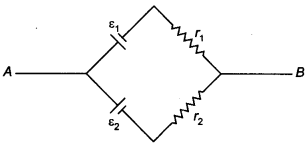
(a ) The equivalent emf εeq of the two cells is between ε1 and ε2 i.e. ε1 < εeq < ε2.
(b) The equivalent emf εeq is smaller than ε1.
(c) The eeq is given by εeq= ε1 + ε2 always.
(d) zeq is independent of internal resistances r1 and r2.
Answer/Explanation
Answer: a
Explaination:
(a) The equivalent emf of this combination is given by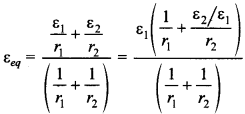
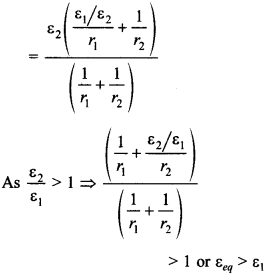
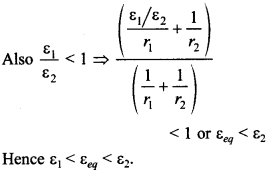
3. A resistance R is to be measured using a meter bridge. Student chooses the standard resistance S to be 100 Ω He finds the null point at l1 = 2.9 cm. He is told to attempt to improve the accuracy. Which of the following is a useful way? [NCERT Exemplar]
(a) He should measure l1 more accurately.
(b) He should change Sto 1000 Ω and repeat the experiment.
(c) He should change S to 3 Ω and repeat the experiment.
(d) He should give up hope of a more accurate measurement with a meter bridge.
Answer/Explanation
Answer: c
Explaination:
(c) The bridge is said to be balanced if the ratio of the resistances in same branch is equal![]()
Since here, R : S = 2.9 : 97.1, then the value of S is nearly 33 times to that of R. In order to make this ratio 1 : 1, it is necessary to reduce the value of S nearly \(\frac{1}{33}\) times i.e., nearly 3 Ω.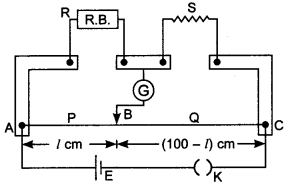
4. Two cells of emf’s approximately 5 V and 10 V are to be accurately compared using a potentiometer of length 400 cm. [NCERT Exemplar]
(a) The battery that runs the potentiometer should have voltage of 8 V.
(b) The battery of potentiometer can have a voltage of 15 V and R adjusted so that the potential drop across the wire slightly exceeds 10 V.
(c) The first portion of 50 cm of wire itself should have a potential drop of 10 V.
(d) Potentiometer is usually used for comparing resistances and not voltages.
Answer/Explanation
Answer: b
Explaination:
(b) The potential drop along the wires of potentiometer should be greater than emfs of cells. Here, values of emfs of two cells are given as 5 V and 10 V, therefore, the potential drop along the potentiometer wire must be more than 10 V.
5. Consider a simple circuit shown in figure stands for a variable resistance R’. R’ can vary from R0 to infinity, r is internal resistance of the battery (r << R << R0). [NCERT Exemplar]
(a) Potential drop across AB is not constant as R0 is varied.
(b Current through R0 is nearly a constant as R0 is varied.
(c) Current I depends sensitively on R0.
(d) \(I \geq \frac{V}{r+R}\) always.
Answer/Explanation
Answer: d
Explaination:
(d) In parallel grouping of resistance, same potential difference appeared across each resistance but current distributed in reverse ratio of their resistance,
i.e i ∝ \(\frac{1}{R}\)
P.d across AB and r = v, equivalent resistance of parallel combination R’ < R, therefore current
\(I \leq \frac{V}{R+r}\)
6. In a meter bridge, the point D is a neutral point (figure). [NCERT Exemplar]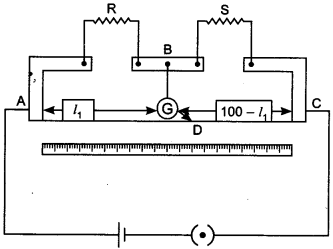
(a) The meter bridge can have other neutral point for this set of resistances.
(b) When the jockey contacts a point on meter wire left of D, current flows to B from the wire.
(c) When the jockey contacts a point on the meter wire to the right of D, current flows from B to the wire through galvanometer.
(d) When R is increased, the neutral point shifts to left.
Answer/Explanation
Answer: c
Explaination:
(c) If in balanced position of bridge AB = l,
When there is no deflection in galvanometer there is no current across the galvanometer, then points B and D are at same potential. That point at which galvanometer shows no deflection is called null point, When the jockey contacts a point on the meter wire to the right of D, the potential drop across AD is more than potential drop across AB, which brings the potential of point D less than that of B, hence current flows from B to D in the galvanometer wire.
7. Which of the following is wrong? Resistivity of a conductor is
(a) independent of temperature.
(b) inversely proportional to temperature.
(c) independent of dimensions of conductor.
(d) less than resistivity of a semiconductor.
Answer/Explanation
Answer: a
Explaination:
(a) Resistivity is property of material and inversely proportional to temperature for conductor, \(\rho=\frac{m}{n e^{2} \tau}\).
8. Drift velocity vd varies with the intensity of electric field as per the relation
(a) vd ∝ E
(b) vd ∝ \(\frac{1}{E}\)
(c) vd = constant
(d) vd ∝ E²
Answer/Explanation
Answer: a
Explaination:
(a) Drift velocity vd = \(\frac{e E}{m} \tau\), i.e. vd ∝ E
9. For measurement of potential difference, a potentiometer is preferred over voltmeter because
(a) potentiometer is more sensitive than voltmeter.
(b) the resistance of potentiometer is less than voltmeter.
(c) potentiometer is cheaper than voltmeter.
(d) potentiometer does not take current from the circuit.
Answer/Explanation
Answer:
Explaination: (d) Potentiometer works on null deflection method.
10. For a cell, the graph between the potential difference (V) across the terminals of the cell and the current (I) drawn from the cell is shown in the figure.
The e.m.f. and the internal resistance of the cell are
(a) 2V, 0.5 Ω
(b) 2V, 0.4 Ω
(c) > 2V, 0.5 Ω
(d) > 2V, 0.4 Ω
Answer/Explanation
Answer: b
Explaination:
(b) E.m.f. is the value of voltage, when no current is drawn from the circuit so E= 2 V.
Also r = slope = \(\frac{2}{5}\) = 0.4 Ω
11. A Daniel cell is balanced on 125 cm length of a potentiometer wire. Now the cell is short-circuited by a resistance 2 ohm and the balance is obtained at 100 cm. The internal resistance of the Daniel cell is
(a) 0.5 ohm
(b) 1.5 ohm
(c) 1.25 ohm
(d) 4/5 ohm
Answer/Explanation
Answer:
Explaination: a
12. When there is an electric current through a conducting wire along its length, then an electric field must exist
(a) outside the wire but normal to it.
(b) outside the wire but parallel to it.
(c) inside the wire but parallel to it.
(d) inside the wire but normal to it.
Answer/Explanation
Answer: c
Explaination:
(c) Electric field parallel to wire inside creates potential difference and electrostic force on electrons.
13. Three resistors each of 2 ohm are connected together in a triangular shape. The resistance between any two vertices will be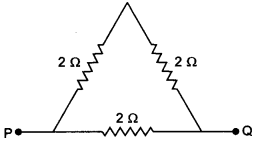
(a) 4/3 ohm
(b) 3/4 ohm
(c) 3 ohm
(d) 6 ohm
Answer/Explanation
Answer: a
Explaination:
(a) Equivalent resistance of the combination![]()
14. From the graph between current I and voltage V shown below, identify the portion corresponding to negative resistance
(a) AB
(b) BC
(c) CD
(d) DE
Answer/Explanation
Answer: c
Explaination:
(c) For portion CD slope of the curve is negative i.e. resistance be negative.
15. A battery consists of a variable number V of identical cells having internal resistances connected in series. The terminals of battery are short circuited and the current i is measured. Which of the graph below shows the relationship between i and n?
Answer/Explanation
Answer: d
Explaination: (d) I = \(\frac{n E}{n r}=\frac{E}{r}\). current is independent of n.
16. A charge is moving across a junction, then
(a) momentum will be conserved.
(b) momentum will not be conserved.
(c) at some places momenturii will be conserved and at some other places momentum will not be conserved.
(d) none of these.
Answer
Answer: d
17. Which of the following I-V graph represents ohmic conductors?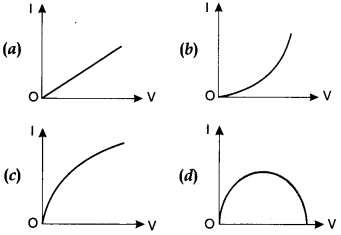
Answer
Answer: a
18. The I-V characteristics shown in figure represents
(a) ohmic conductors
(b) non-ohmic conductors
(c) insulators
(d) superconductors
Answer
Answer: b
19. Which of the following is correct for V-I graph of a good conductor?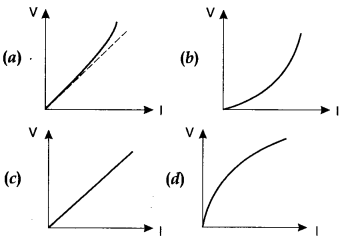
Answer
Answer: a
20. The resistivity of alloy manganin is
(a) Nearly independent of temperature
(b) Increases rapidly with increase in temperature
(c) Decreases with increase in temperature
(d) Increases rapidly with decrease in temperature
Answer
Answer: a
21. An electric heater is connected to the voltage supply. After few seconds, current gets its steady value then its initial current will be
(a) equal to its steady current
(b) slightly higher than its steady current
(c) slightly less than its steady current
(d) zero
Answer
Answer: b
22. In the series combination of two or more than two resistances
(a) the current through each resistance is same.
(b) the voltage through each resistance is same.
(c) neither current nor voltage through each re-sistance is same.
(d) both current and voltage through each resis¬tance are same.
Answer
Answer: a
23. Combine three resistors 5 Q, 4.5 Q and 3 Q in such a way that the total resistance of this combination is maximum
(a) 12.5 Q
(b) 13.5 Q
(c) 14.5 Q
(d) 16.5 Q
Answer
Answer: a
24. A cell having an emf E and internal resistance r is connected across a variable external resistance R. As the resistance R is increased, the plot of potential difference V across R is given by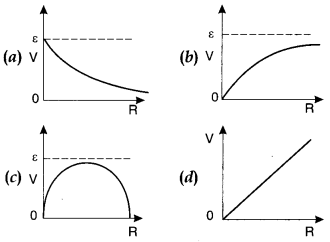
Answer
Answer: b
25. In parallel combination of n cells, we obtain
(a) more voltage
(b) more current
(c) less voltage
(d) less current
Answer
Answer: b
26. If n cells each of emf e and internal resistance r are connected in parallel, then the total emf and internal resistance will be
Answer
Answer: a
27. In a Wheatstone bridge if the battery and galvanometer are interchanged then the deflection in galvanometer will
(a) change in previous direction
(b) not change
(c) change in opposite direction
(d) none of these.
Answer
Answer: b
28. When a metal conductor connected to left gap of a meter bridge is heated, the balancing point
(a) shifts towards right
(b) shifts towards left
(c) remains unchanged
(d) remains at zero
Answer
Answer: a
29. In a potentiometer of 10 wires, the balance point is obtained on the 7th wire. To shift the balance point to 9th wire, we should
(a) decrease resistance in the main circuit.
(b) increase resistance in the main circuit.
(c) decrease resistance in series with the cell whose emf is to be measured.
(d) increase resistance in series with the cell whose emf is to be determined.
Answer
Answer: d
30. AB is a wire of potentiometer with the increase in the value of resistance R, the shift in the balance point J will be
(a) towards B
(b) towards A
(c) remains constant
(d) first towards B then back towards A.
Answer
Answer: a
31. There are n similar conductors each of resistance R. The resultant resistance comes out to be x when connected in parallel. If they are connected in series, the resistance comes out to be ________ .
Answer/Explanation
Answer:
Explaination:
n²x
In parallel, x = \(\frac{R}{n}\) or R = nx n
In series, R + R + R …. n times = nR = n(nx) = n²x
32. In the circuit shown, potential difference between X and Y is ________ and across 40 Ω is ________ .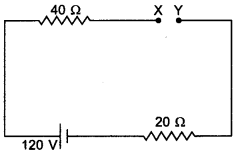
Answer/Explanation
Answer:
Explaination: 120 V, 0 V [In open circuit of a cell V = E for XY and no current flows though 40 Ω]
33. The figure below shows currents in a part of electric circuit. The current i is ________ .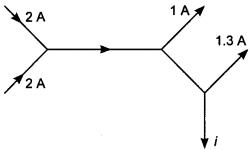
Answer/Explanation
Answer:
Explaination: 1.7 A
34. A wire is stretched so as to change its length by 0.1%, the percentage increase in its resistance will be _______ .
Answer/Explanation
Answer:
Explaination: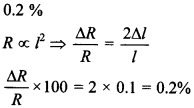
35. The current in the given circuit will be ________ .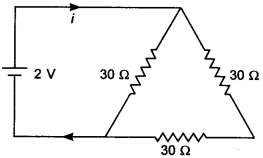
Answer/Explanation
Answer:
Explaination: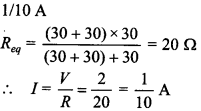
36. A cell of emf E is connected with an external resistance R, then p.d. across cell is V. The internal resistance of cell will be ________ .
Answer/Explanation
Answer:
Explaination:![]()
37. The figure shows a network of current and the magnitude of current. The current I will be ________ .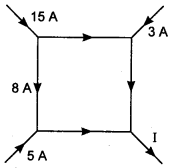
Answer/Explanation
Answer:
Explaination: 23 A, using KirchhofTs law 7=15 + 5 + 3 = 23 A
38. When electrons drift in a metal from lower to higher potential, does it mean that all the free electrons of the metal are moving in the same direction? [NCERT Example; Delhi 2012]
Answer/Explanation
Answer:
Explaination: No. As the collision is a random process, the electrons cannot get deflected in the same direction.
39. A steady current flows in a metallic conductor of non-uniform cross-section. Which of these quantities is constant along the conductor: current, current density, drift speed and electric field?
Answer/Explanation
Answer:
Explaination: Current, because in series, the current is same throughout the wire.
40. The electron drift arises due to the force experienced by electrons in the electric field inside the conductor. But force should cause acceleration. Why then do the electrons acquire a steady average drift speed?
Answer/Explanation
Answer:
Explaination:
An electron does accelerate but loose its drift speed during the subsequent collisions with a positive ion of the metal. Therefore, it is the average drift speed which is acquired by the electron.
41. The electron drift speed is estimated to be only a few mm s-1 for currents in the range of a few amperes? How then is current established almost the instant a circuit is closed?
Answer/Explanation
Answer:
Explaination:
It is the electric field which spreads throughout a circuit with speed of light. At every point, a local electron drift is induced by the field. This way, the current attains its steady value almost instantaneously.
42. Is there a net field inside the cell when the circuit is closed and a steady current passes through? Explain.
Answer/Explanation
Answer:
Explaination:
When circuit is closed, the current flows in the direction of electrostatic field outside, and opposite to the direction of electrostatic field inside the cell. The latter fact shows that there is a net field inside the cell opposite to the electrostatic field.
43. Plot a graph showing the variation of resistance of a conducting wire as a function of its radius, keeping the length of the wire and its temperature as constant. [Foreign 2013]
Answer/Explanation
Answer:
Explaination: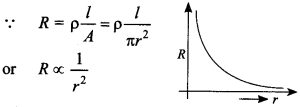
44. V-I graph for a metallic wire at two different temperatures Tx and T2 is as shown in the figure. Which of the two temperatures is higher and why?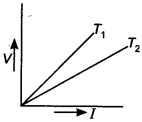
Answer/Explanation
Answer:
Explaination:
Since, resistance = slope of V – I graph. In the figure, the slope of Tx is large, so T1 represents the higher temperature as the resistance increases with the temperature for a conductor.
45. The emf of a cell is always greater than its terminal voltage. Why? Give reason. [Delhi 2013]
Answer/Explanation
Answer:
Explaination:
The current always flows from higher to lower potential. To produce the current to an external circuit, the emf must be greater than the terminal voltage, i.e. the potential difference across the external circuit.
ε = V + Ir
46. You are given three constantan wires P, Q and R of length and area of cross-section (L, A), (2L, \(\frac{A}{2}\)), (\(\frac{L}{2}\)2A) respectively. Which has highest resistance? [DoE]
Answer/Explanation
Answer:
Explaination: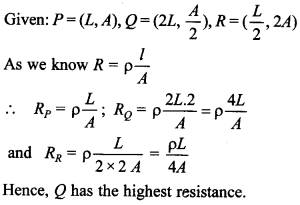
47. Two wires of equal length, one of copper and the other of manganin have the same resistance. Which wire is thicker? [AI2012]
Answer/Explanation
Answer:
Explaination:
As the resistivity of manganin (2) is greater than the resistivity of copper (1). So, the manganin wire is thicker.
48. Nichrome and copper wires of same length and same radius are connected in series. Current/is passed through them. Which wire gets heated up more? Justify your answer. [AI 2017]
Answer/Explanation
Answer:
Explaination:
Nichrome wire having more resistivity () will heat up more, as heat produced = I²R = I²\(\frac{l}{A}\)
49. State the condition for maximum current to be drawn from a cell.
Answer/Explanation
Answer:
Explaination:
\(I=\frac{E}{R+r}\); when the external resistance,
R = 0 (i.e. cell is short-circuited), then the maximum current will be drawn from a cell.
50. State the condition under which the terminal potential difference across a battery and its emf are equal.
Answer/Explanation
Answer:
Explaination:
∵ V = E – Ir, when the battery is in open circuit, i.e. no current is being drawn from the cell. Therefore, terminal potential difference is equal to the emf to the cell.
51. A car battery is of 12 V. Eight dry cells of 1.5 V connected in series also give 12 V, but such a combination is not used to start a car. Why?
Answer/Explanation
Answer:
Explaination:
Dry cells used in series will have high resistance (=10 Ω) and hence provide low current, while a car battery has low internal resistance (0.1 Ω) and hence gives high current for the same emf, needed to start the car.
52. Graph showing the variation of current versus voltage for a material GaAs is shown in the figure. Identify the region of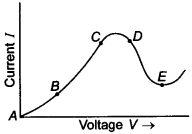
(i) negative resistance, [Dehradun 2019]
(ii) where Ohm’s law is obeyed. [Delhi 2015].
Answer/Explanation
Answer:
Explaination:
(i) DE is the negative resistance region.
(ii) Ohm’s law is obeyed in the region AB.
53. Define the term ‘electrical conductivity’ of a metallic wire. Write its SI unit. [Delhi 2014]
Answer/Explanation
Answer:
Explaination:
Electric conductivity () is defined as the reciprocal of electric resistivity
i.e. \(\sigma=\frac{1}{\rho}\)
Its SI unit is Ω-1 m-1, mho m-1 or siemen m-1.
54. Give an example of a material each for which temperature coefficient of resistivity is
(i) positive and
(ii) negative. [CBSE Sample Paper 2016]
Answer/Explanation
Answer:
Explaination:
The temperature coefficient of resistivity is
(i) positive for Cu (copper) and nichrome, and
(ii) negative for Si (semiconductor).
55. Show variation of resistivity of copper as a function of temperature in a graph. [Chennai 2019, Delhi 2014]
Answer/Explanation
Answer:
Explaination:
56. Two identical cells, each of emf E, having negligible internal resistance r, are connected in parallel with each other across an external resistance R. What is the current through this resistance? [AI2013]
Answer/Explanation
Answer:
Explaination:
For parallel arrangement of two identical cells, the total resistance of the circuit = R (cells have negligible internal resistance) Potential difference across the resistor = E.
So, current through the resistance, \(I=\frac{E}{R}\)
57. The plot of the variation of potential difference across a combination of three identical cells in series, versus current is as shown here. What is the emf of each cell?
Answer/Explanation
Answer:
Explaination:
When7=0, Vmax = E = 6V
Thus, an emf of each cell = \(\frac{6}{3}\) = 2 volts.
58. Why resistance becomes more in series combination?
Answer/Explanation
Answer:
Explaination:
It is due to the increase in effective length of the conductor, because R ∝ l.
59. Why resistance becomes less in parallel combination?
Answer/Explanation
Answer:
Explaination:
It is due to the increase in effective area of cross-section ofthe conductor, because R ∝ l/A.
60. Two similar wires of same length and same area of cross-section but of different material,, having resistivity p, and p2 are connected end to end (in series). Calculate the effective resistivity of their combination.
Answer/Explanation
Answer:
Explaination: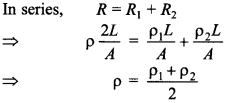
61. Two similar wires of same length and same area of cross-section but of different material having resistivity pj and p2 are connected side by side i.e. in parallel. Calculate the effective resistivity of their combination.
Answer/Explanation
Answer:
Explaination:
62. In an experiment on meter bridge, if the balancing length AC is x, what would be its value, when the radius of the meter bridge wire AB is doubled? Justify your answer. [AI 2011C]
Answer/Explanation
Answer:
Explaination:
At the balance point, we have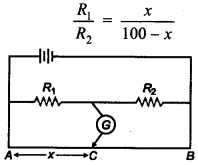
As R1 and R2 remain the same, then x will also remain the same. It will not depend upon the diameter of the wire.
63. A cell of negligible internal resistance is connected in series to the wire of a potentiometer. If potentiometer wire is changed and in its place another wire of different material having diameter twice of the first wire is used keeping the length constant, then how the balance point will change?
Answer/Explanation
Answer:
Explaination: Balance point will not change.
64. How can we increase the sensitivity of a potentiometer? [Foreign 2017]
Answer/Explanation
Answer:
Explaination:
By reducing potential gradient.
Potential gradient can be reduced by
(i) increasing length of the wire, and
(ii) reducing current in the main circuit.
65. Why is the potentiometer preferred .to a voltmeter for measuring emf of a cell? [Dehradun 2019]
Answer/Explanation
Answer:
Explaination:
Emf measured by the potentiometer is more accurate because the cell is in open circuit giving no current.
